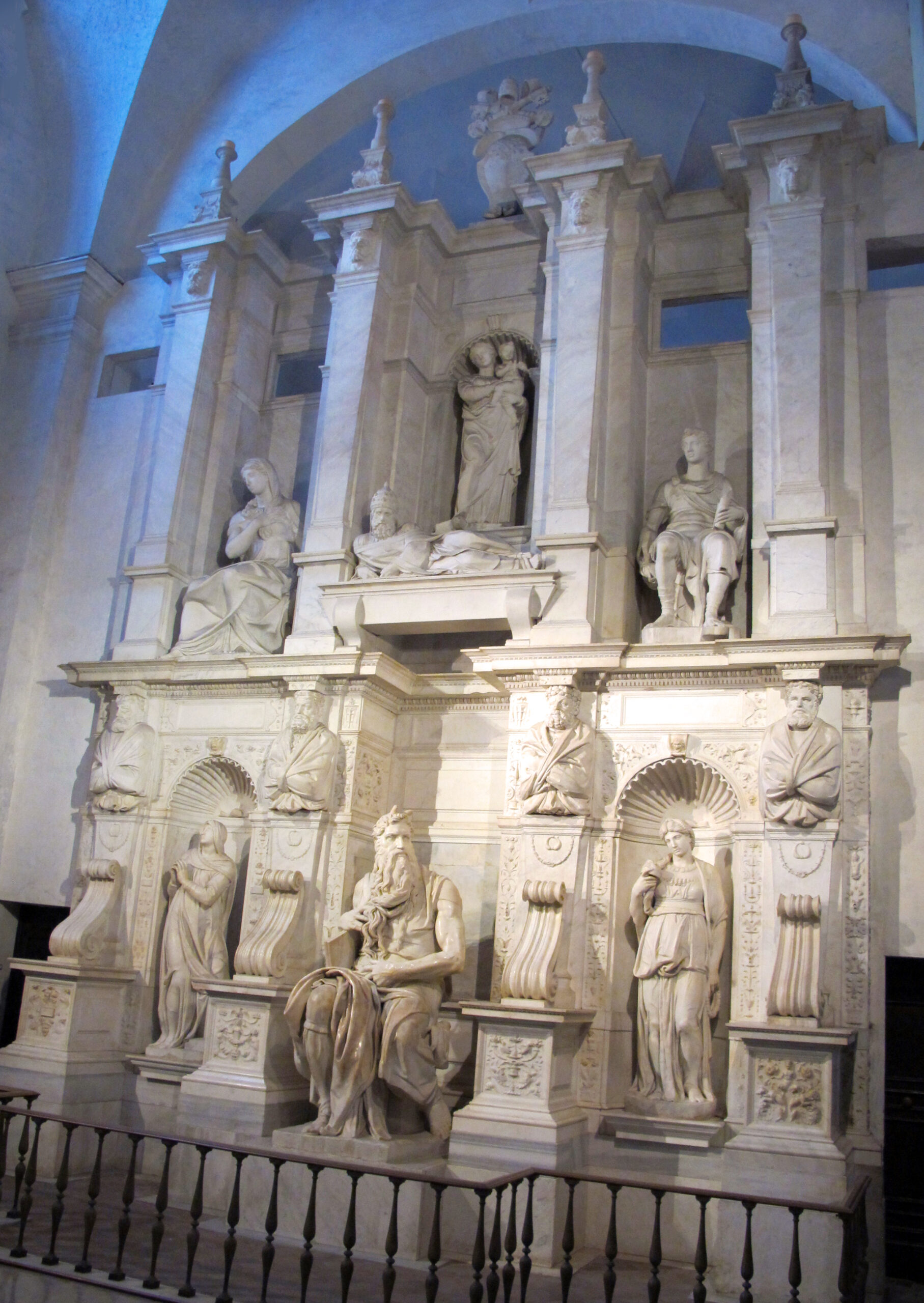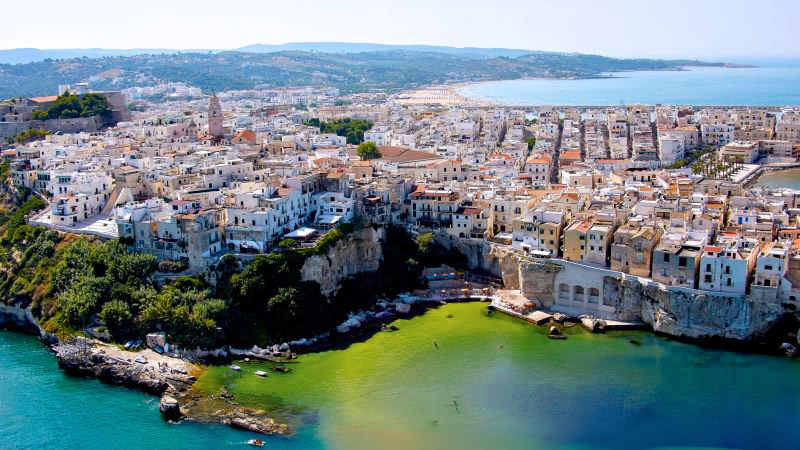Part 3 of a 4 Part Series
The story of the Tomb of Pope Julius II is one that is filled with intrigue, double crosses and two geniuses placed at odds. Out of the story emerged one man’s greatest disappointment and one of mankind’s greatest treasures.
The story of the Tomb for Pope Julius II began in 1505, when the Pope commissioned Michelangelo to build his burial tomb and its extensive statuary. The sculptor spent eight months choosing marble at Carrara for the project. Soon after construction began, the Pope ordered the work to stop. To this day the precise reason is unclear. As originally conceived, the tomb would have been a colossal structure. This project became perhaps the greatest disappointment of Michelangelo’s life. It is suspected that the Pontiff was short of money. Donato Bramante wanted as much money as the Church’s coffers could muster for his building project of St. Peter’s Basilica, plus he was jealous of Michelangelo’s commission for the tomb. Additionally, he hated the sculptor for having discovered that Bramante was using substandard materials in some of the areas of the Vatican. In short, the two men despised one another.
Bramante convinced Pope Julius that it would be bad luck to have his tomb constructed while he was still of this Earth and that Michelangelo’s time would be better spent on the Sistine Chapel ceiling in the Vatican Palace. Remember, Michelangelo did not think highly of painting and was first and foremost a sculptor. He initially refused the commission and it looked as though Bramante’s scheme to bring discredit upon the great master would succeed. Rather, it backfired enormously as the fresco is considered to be the world’s greatest large scale painting, comparable only to that of “The Last Judgment,” also in the Sistine Chapel and also painted by Michelangelo.
With the Sistine Chapel ceiling completed in 1512, Michelangelo resumed work on the tomb. Between 1512 and 1513, he completed three sculptures for the project: the Dying Slaves, the Rebellious Slaves (now in the Louvre, Paris) and Moses. Julius died in February 1513 and a new contract was drawn up in May which specified a wall tomb. Three years later, a new contract was agreed upon between Michelangelo and Pope Julius’ heirs, who demanded the completion of the project. During the next decade, Michelangelo carved The Genius of Victory and four unfinished Slaves. In 1532, yet another contract was signed by Michelangelo involving the wall-tomb. Finally, in 1545 the tomb in its final form was completed and installed in San Pietro in Vincoli (St. Peter in Chains) in Rome. It included Michelangelo’s Moses along with the statues Leah and Rachel (two of the wives of Jacob from the Old Testament) on the lower level and several other sculptures (not by Michelangelo) on the upper level.
The most famous sculpture associated with the tomb is the figure of Moses, which Michelangelo felt that this was his most lifelike creation. Moses is an imposing figure – he is nearly eight feet high sitting down, with enormous muscular arms and an angry, intense look in his eyes. Under his arms he carries the tablets of the law – the stones inscribed with the Ten Commandments that he has just received from God on Mt. Sinai. Michelangelo managed to create an intense, energetic figure even though Moses is seated. While the marble itself is still, it seems as though his beard is moving and flowing and that his arms and torso are about to shift.
Aside from Moses, the other two sculptures completed for the tomb were the Prigioni (meanings prisoners, but renamed the slaves in the 19th century), which were eliminated from the monument in its final version. In the first version of the tomb, a series of statues featuring chained figures in various poses were to be placed on each side of the niches, totaling either 16 or 20 Prigioni. Over time, these were reduced to 12 in the second project, eight in the third and four in the fourth version, before they were completely eliminated from the project in 1542.
The first examples, the Dying Slave and the Rebellious Slave were sculpted in Rome. In 1546, Michelangelo gave the two works to his friend, Roberto Strozzi, for his hospitality when the artist fell gravely ill in Rome during the summer of 1544. Michelangelo’s convalescence lasted until mid-1546. Strozzi brought the Prigioni to France when he was exiled to Lyon in 1550. Eventually they became part of the Richelieu family collection, where they remained for almost two centuries. Ultimately, the statues were confiscated by the French government and are now in the Louvre.
The Florentine Prigioni are four unfinished sculptures and include the Young Slave, the Bearded Slave, the Atlas Slave and the Awakening Slave. Each was sculpted in the latter half of the 1520s, when Michelangelo was employed at San Lorenzo in Florence. They were sold, along with The Genius of Victory to the Grand Duke Cosimo I, who placed them in the four corners of the Grotto of Buontalenti near the end of the 16th century. They were removed from there in 1908 to join the Michelangelo collection which had been formed in the Galleria dell’Accademia in Florence, where each remains to this day.
The Genius of Victory was also produced as part of a design for the tomb of Julius II. Victory forms an interesting footnote in history. Left in the artist’s studio after his final departure from Florence in 1534, it became the property of his nephew, Leonardo Buonarroti, who first tried to sell it in 1544 without obtaining the necessary authorization from his uncle. Then, at the suggestion of Daniele da Volterra, he tried to place it on Michelangelo’s tomb in Santa Croce (1564), but Giorgio Vasari, who was redesigning the church’s interior, was against it being used there. Vasari suggested giving the statue to Duke Cosimo I de’ Medici and was placed in the Salone dei Cinquecento of the Palazzo Vecchio in Florence.
In our final installment in this series, we will examine the remainder of statues executed by Michelangelo, including those for the Tomb of Giuliano de’ Medici, Apollo and the Florentine Pietà.





